Genealogy
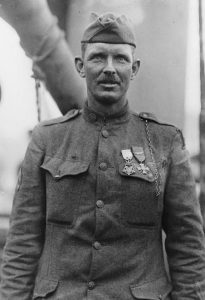 Recently, I found out that my family is related to Alvin Cullum York, who was one of the most decorated United States Army soldiers of World War I. York is my 8th cousin once removed on my dad’s side of the family. York received the Medal of Honor for leading an attack on a German machine gun nest, taking 35 machine guns, killing at least 25 enemy soldiers, and capturing 132. York’s Medal of Honor action occurred during the portion of the Meuse-Argonne Offensive in France, which was led by the United States, and was intended to breach the Hindenburg line and force the Germans to surrender.
Recently, I found out that my family is related to Alvin Cullum York, who was one of the most decorated United States Army soldiers of World War I. York is my 8th cousin once removed on my dad’s side of the family. York received the Medal of Honor for leading an attack on a German machine gun nest, taking 35 machine guns, killing at least 25 enemy soldiers, and capturing 132. York’s Medal of Honor action occurred during the portion of the Meuse-Argonne Offensive in France, which was led by the United States, and was intended to breach the Hindenburg line and force the Germans to surrender.
York was born in rural Tennessee on December 13, 1887, the third of eleven children of William and Mary (Brooks) York. His parents farmed, and his father worked as a blacksmith. The York children had minimal schooling because they helped provide for the family, which included hunting, fishing, and hiring out as laborers. After the death of York’s father, he assisted in caring for his younger siblings, and found work as a logger and on construction crews. York wen to church on a regular basis, but he also drank heavily and had a reputation for fistfighting. In 1914 he had a conversion experience, and vowed to improve. He became even more devoted to the Church of Christ in Christian Union.
Upon being drafted into World War I, York initially claimed conscientious objector status on the grounds that his denomination forbade violence. It was because of his internal struggle about whether or not war was the same 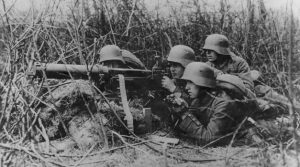 as murder. York prayed about it for the better part of a whole night, before feeling led to proceed with his military assignment. York joined the 82nd Division as an infantry private, and went to France in 1918. He was a part of the group of soldiers know as dough boys. In October 1918, York was promoted to corporal, as one of a group of 17 soldiers assigned to infiltrate German lines and silence a machine gun position. After the American patrol had captured a large group of enemy soldiers, German small arms fire killed six Americans and wounded three. York was the highest ranking of those still able to fight, so he took charge. While his men guarded the prisoners, York attacked the machine gun position, dispatching several German soldiers with his rifle. By the time six Germans charged him with bayonets he was out of rifle ammunition, so he drew his pistol and shot them all. The German officer responsible for the machine gun position had emptied his pistol while firing at York, but missed. This officer then offered to surrender, and York accepted. York and his men marched back to their unit’s command post with more than 130 prisoners. York was immediately promoted to sergeant, and was awarded the Distinguished Service Cross. After further investigation the award was upgraded to the Medal of Honor. York became a national hero and international celebrity. He also received decorations from several foreign countries, including France, Italy, and Montenegro.
as murder. York prayed about it for the better part of a whole night, before feeling led to proceed with his military assignment. York joined the 82nd Division as an infantry private, and went to France in 1918. He was a part of the group of soldiers know as dough boys. In October 1918, York was promoted to corporal, as one of a group of 17 soldiers assigned to infiltrate German lines and silence a machine gun position. After the American patrol had captured a large group of enemy soldiers, German small arms fire killed six Americans and wounded three. York was the highest ranking of those still able to fight, so he took charge. While his men guarded the prisoners, York attacked the machine gun position, dispatching several German soldiers with his rifle. By the time six Germans charged him with bayonets he was out of rifle ammunition, so he drew his pistol and shot them all. The German officer responsible for the machine gun position had emptied his pistol while firing at York, but missed. This officer then offered to surrender, and York accepted. York and his men marched back to their unit’s command post with more than 130 prisoners. York was immediately promoted to sergeant, and was awarded the Distinguished Service Cross. After further investigation the award was upgraded to the Medal of Honor. York became a national hero and international celebrity. He also received decorations from several foreign countries, including France, Italy, and Montenegro.
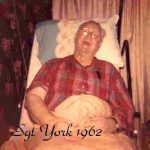
To reward their hero, some businessmen in Tennessee organized the purchase of a farm for York, his new wife, and their growing family. York later formed a charitable foundation to improve educational opportunities for children in rural Tennessee, as a way of giving back o his home state. In the 1930s and 1940s, York worked as a project superintendent for the Civilian Conservation Corps and managed construction of the Byrd Lake reservoir at Cumberland Mountain State Park, after which he served for several years as park superintendent. In his later years, York was confined to bed by health problems. He died in Nashville, Tennessee, on September 2, 1964 and was buried at Wolf River Cemetery in his hometown of Pall Mall.
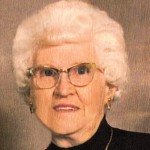 There is a strange phenomenon that occurs sometimes, after someone we love passes away. I’m not talking about seeing their ghost, because I don’t believe in ghosts. Besides, the people I have seen, since the passing of loved ones, are real. I have noticed this after the passing of several people, and in some ways it is odd, but in other ways it is comforting, because it shows me that the person I love is still living in my memory files. In reality, I suppose it’s just me, finding characteristics in people around me that remind me of a lost loved one.
There is a strange phenomenon that occurs sometimes, after someone we love passes away. I’m not talking about seeing their ghost, because I don’t believe in ghosts. Besides, the people I have seen, since the passing of loved ones, are real. I have noticed this after the passing of several people, and in some ways it is odd, but in other ways it is comforting, because it shows me that the person I love is still living in my memory files. In reality, I suppose it’s just me, finding characteristics in people around me that remind me of a lost loved one.
After my great aunt, Gladys Pattan Byer Cooper was killed in a plane crash, I used to see an older woman at the mall, just about every weekend. She reminded me so much of Aunt Gladys that I could almost imagine it was really her. Of course, the woman didn’t look exactly like Aunt Gladys, but she looked enough like her to bring back memories of years gone by, and a little sadness at the way she had passed. It seemed so senseless, so unbelievable that it could have happened in such a manner. One minute Aunt Gladys was fine and taking a trip to a family reunion, and the next, her life was over.
I find it strange that this phenomenon doesn’t seem to happen all the time. It only seems to happen in deaths that don’t make sense to me. I’m not looking for people who remind me of the person who died unexpectedly, they just suddenly appear. As I said, they are real people, please understand that. They just have similar features to my loved one who is gone. It doesn’t scare me, but rather it is just a strange reminder that my loved one existed. That their life was important. That their memory is, and always will be with me.
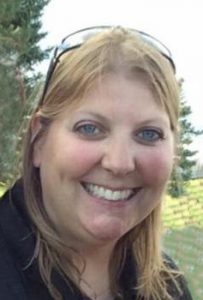
Since my 2nd cousin once removed, Jackie Morton passed away on March 9, 2018, I have thought about her many times. She was such a sweet, loving girl, and her passing simply makes no sense to me. One day she was fine, and the next day she was gone. Then, a few days later, while walking at the mall, I saw someone who really reminded me of Jackie. Had I not known better, I could have really thought it was her…though I knew it was not, for it could not be her. She has gone to Heaven now. Nevertheless, Jackie’s memory, like the memory of her great grandmother, my Great Aunt Gladys will always be with me.
I thought I saw you at the mall today. Though I knew it could not be you at all, for you are gone. I miss you so, and I wish you could still be here on Earth with us. But sadly, that is not to be, and never could be. You will always be with us in our thoughts, and in our memories…and we will always miss you so.
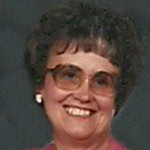 On Saint Patrick’s Day, my cousin Michael McDaniels and his wife, Deena took his mom, my Aunt Bonnie McDaniels to a celebration in downtown Casper, Wyoming, as part of her birthday celebration. That reminded me about the many times that my husband, Bob Schulenberg and I would run into Aunt Bonnie and her husband, my Uncle Jack at the fair with their grandchildren. They took them every year and the kids had a great time. We would run into them, because we still went to the fair at that time. I always thought it was great that they took their grandkids every year, because lots of kids don’t get to go. Either their parents couldn’t afford it, or just figured the kids could wait until they were old enough to go on their own. Aunt Bonnie and Uncle Jack’s grandkids didn’t have to worry about that, because they got to go every year.
On Saint Patrick’s Day, my cousin Michael McDaniels and his wife, Deena took his mom, my Aunt Bonnie McDaniels to a celebration in downtown Casper, Wyoming, as part of her birthday celebration. That reminded me about the many times that my husband, Bob Schulenberg and I would run into Aunt Bonnie and her husband, my Uncle Jack at the fair with their grandchildren. They took them every year and the kids had a great time. We would run into them, because we still went to the fair at that time. I always thought it was great that they took their grandkids every year, because lots of kids don’t get to go. Either their parents couldn’t afford it, or just figured the kids could wait until they were old enough to go on their own. Aunt Bonnie and Uncle Jack’s grandkids didn’t have to worry about that, because they got to go every year.
Aunt Bonnie also loved attending the various events of her grandchildren, and I’m sure she was that way with her kids too. I usually saw her at the track meets at Grant School, where both of our grandchildren went to elementary school. Of course, Uncle Jack had to work in those days, so he didn’t get the pleasure of coming to the track meets. Aunt Bonnie was always so excited about the events, and spent the day cheering her grandson, Anthony McDaniels on to, hopefully, victory. For Aunt Bonnie, her family was everything. She wanted nothing more than to spend time surrounded by them. They were the product of the great love she had for Uncle Jack, and in them, her life was complete.
Aunt Bonnie has blessed many people in her lifetime. Her cakes have graced many a wedding, but it was her 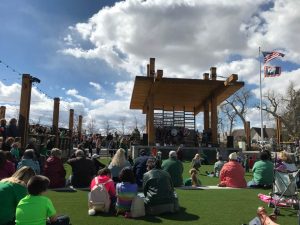 smile and her cheerful way that were the real blessing. Every time Bob and I ran into her, oddly most often while grocery shopping at Walmart, she and Uncle Jack were always pleased to run into us, and we always had a nice conversation…even if it was a short conversation. We just always enjoyed running into them. Things are different for Aunt Bonnie now that Uncle Jack has gone to Heaven, but it pleases me to see her kids taking her out to do the fun stuff. It’s almost like going full circle. What she and Uncle Jack did for their kids, they are now doing for her. And what a special treat it must be for her. She got to go to something she wouldn’t have done on her own. Today is Aunt Bonnie’s birthday. Happy birthday Aunt Bonnie!! Have a great day!! We love you!!
smile and her cheerful way that were the real blessing. Every time Bob and I ran into her, oddly most often while grocery shopping at Walmart, she and Uncle Jack were always pleased to run into us, and we always had a nice conversation…even if it was a short conversation. We just always enjoyed running into them. Things are different for Aunt Bonnie now that Uncle Jack has gone to Heaven, but it pleases me to see her kids taking her out to do the fun stuff. It’s almost like going full circle. What she and Uncle Jack did for their kids, they are now doing for her. And what a special treat it must be for her. She got to go to something she wouldn’t have done on her own. Today is Aunt Bonnie’s birthday. Happy birthday Aunt Bonnie!! Have a great day!! We love you!!
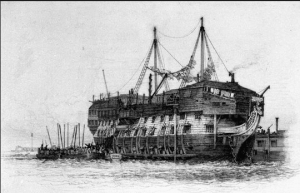 The reasons that Britain decided to start a Penal Colony at Botany Bay, Australia are not fully agreed upon. Some say that that there were deeper motives than just a place to house their criminals. The soil at Botany Bay was perfect for growing flax. I suppose that the prisoners would need to be doing some kind of work as penance for their crimes. Nevertheless, Britain would be making a profit from the flax that was produced thee, and the bay was perfect for a port, which would be necessary to assist with trade. All in all, Botany Bay seemed like the best option for a penal colony for Britain, so the plans were put in place, and before long the penal colony became a reality.
The reasons that Britain decided to start a Penal Colony at Botany Bay, Australia are not fully agreed upon. Some say that that there were deeper motives than just a place to house their criminals. The soil at Botany Bay was perfect for growing flax. I suppose that the prisoners would need to be doing some kind of work as penance for their crimes. Nevertheless, Britain would be making a profit from the flax that was produced thee, and the bay was perfect for a port, which would be necessary to assist with trade. All in all, Botany Bay seemed like the best option for a penal colony for Britain, so the plans were put in place, and before long the penal colony became a reality.
When Governor Phillip arrived in 1788, he asked for carpenters, masons, bricklayers to help set up the colony, along with many tools of the trades. In January of 1788, the first 736 convicts banished from England to Australia arrived in Botany Bay. Over the next 60 years, approximately 50,000 criminals were transported from Great Britain to the Botany Bay in one of the strangest episodes in criminal-justice history. I think many of us have thought that some criminals should be place on a deserted island, but Britain basically did just that…with every criminal, it seems.
The accepted wisdom of the upper and ruling classes in 18th century England was that criminals were inherently defective. They did not believe criminals could be rehabilitated and that they simply required separation from the genetically pure, law-abiding citizens. Consequently, lawbreakers had to be either killed or exiled, because prisons were too expensive, and they criminals were not worth the money. With the American victory in the Revolutionary War, transgressors could no longer be shipped off across the Atlantic, so the English had to look for a colony in some other direction.
Captain Arthur Phillip, a tough but fair career naval officer, was charged with setting up the first penal colony in Australia. The convicts were chained beneath the deck during the entire hellish six-month voyage. The first voyage claimed the lives of nearly 10 percent of the prisoners, which remarkably proved to be a rather good rate. On later trips, up to a third of the unwilling passengers died on the way. These were not hardened criminals by any measure; only a small minority were transported for violent offenses. Among the first group was a 70-year-old woman who had stolen cheese to eat.
Although not confined behind bars, most convicts in Australia had an extremely tough life. The guards who volunteered for duty in Australia seemed to be driven by exceptional sadism. Even small violations of the rules could result in a punishment of 100  lashes with a whip. It was said that blood was usually drawn after five lashes, but they didn’t stop there. Convicts usually ended up walking home in boots filled with their own blood, if they could walk at all. Convicts who attempted to escape were sent to tiny Norfolk Island, 600 miles east of Australia. The conditions there were even more inhumane. The only hope of escape from the horror of Norfolk Island was a “game” in which groups of three prisoners drew straws. The short straw was killed as painlessly as possible and a judge was then shipped in to put the other two on trial, one playing the role of killer, the other as witness. I guess the only hope of escape was, in reality, death. There were no second chances for them.
lashes with a whip. It was said that blood was usually drawn after five lashes, but they didn’t stop there. Convicts usually ended up walking home in boots filled with their own blood, if they could walk at all. Convicts who attempted to escape were sent to tiny Norfolk Island, 600 miles east of Australia. The conditions there were even more inhumane. The only hope of escape from the horror of Norfolk Island was a “game” in which groups of three prisoners drew straws. The short straw was killed as painlessly as possible and a judge was then shipped in to put the other two on trial, one playing the role of killer, the other as witness. I guess the only hope of escape was, in reality, death. There were no second chances for them.
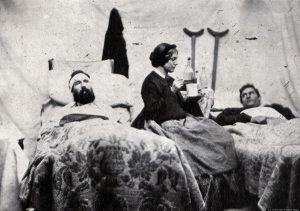 When we think of our nation’s early wars, and really, up until the Persian Gulf War, soldiers were officially men only. Prior to the Persian Gulf War, any women who were in combat were disguised as men, or they were in non-combat roles, such as support staff and nurses. Few women were recognized for their service, much less honored for it, but on March 12, 1776, in Baltimore, Maryland, someone decided to change the way we looked at the effort made by women in wars. And when I say effort know that I include much sacrifice.
When we think of our nation’s early wars, and really, up until the Persian Gulf War, soldiers were officially men only. Prior to the Persian Gulf War, any women who were in combat were disguised as men, or they were in non-combat roles, such as support staff and nurses. Few women were recognized for their service, much less honored for it, but on March 12, 1776, in Baltimore, Maryland, someone decided to change the way we looked at the effort made by women in wars. And when I say effort know that I include much sacrifice.
That day, a public notice appeared in local papers recognizing the sacrifice of women to the cause of the revolution. The notice urged others to recognize women’s contributions as well, and announced, “The necessity of taking all imaginable care of those who may happen to be wounded in the country’s cause, urges us to address our humane ladies, to lend us their kind assistance in furnishing us with linen rags and old sheeting, for bandages.” On and off the battlefield, women were known to support the revolutionary cause by providing nursing assistance. But donating bandages and sometimes applying them was only one form of aid provided by the women of the new United States. From the earliest protests against British taxation, women’s assent and labor 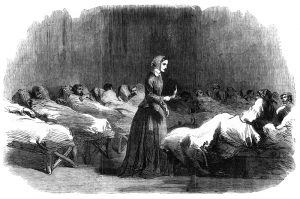 was critical to the success of the cause. The boycotts that united the colonies against British taxation required female participation far more than male participation, in fact, the men designing the non-importation agreements chose to boycott products used mostly by women…how thoughtful of them!!
was critical to the success of the cause. The boycotts that united the colonies against British taxation required female participation far more than male participation, in fact, the men designing the non-importation agreements chose to boycott products used mostly by women…how thoughtful of them!!
Tea and cloth are perhaps the best examples of these boycotted products. While most schoolchildren have read of the men who dressed as Mohawk Indians and dumped large volumes of tea into Boston Harbor at the Boston Tea Party, as a form of opposition to the hated Tea Act, few realize that women…not men…drank most of the tea in colonial America. Samuel Adams and his friends may have dumped the tea in the harbor, but they were far more likely to drink rum than tea when they returned to their homes. Conveniently, their actions actually deprived their wives, mothers, sisters and daughters, and not themselves. The colonists only resorted to an attempted boycott of rum in 1774, after Britain had closed the port of Boston. I guess it was time for drastic measures.
Similarly, when John Adams and other men in power thought it best to stop importing fine British fabrics with 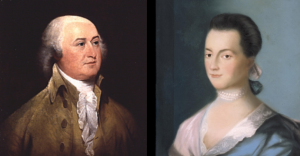 which to make their clothing during the protests of the late 1760s, it had little impact on their daily lives. Wearing homespun cloth may not have been as comfortable nor look as refined as their regular clothing, but it was Abigail and other colonial wives and homemakers, not John and his fellow men, who were forced to spend hours spinning clothes to create their families’ wardrobes. Thus, in 1776, when Abigail begged John to remember the ladies while drafting the U.S. Constitution, she was not begging a favor, but demanding payment of an enduring debt. And her husband, in good conscience could not deny her right, or her important request.
which to make their clothing during the protests of the late 1760s, it had little impact on their daily lives. Wearing homespun cloth may not have been as comfortable nor look as refined as their regular clothing, but it was Abigail and other colonial wives and homemakers, not John and his fellow men, who were forced to spend hours spinning clothes to create their families’ wardrobes. Thus, in 1776, when Abigail begged John to remember the ladies while drafting the U.S. Constitution, she was not begging a favor, but demanding payment of an enduring debt. And her husband, in good conscience could not deny her right, or her important request.

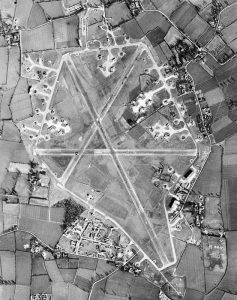 Most of the time, when we think of time and distance here on planet earth, we tend to feel like we are just a speck compared to the size of this planet, and I suppose that is true, but sometimes, our connection to one another is, in reality, much closer than we know. My dad, Allen L “Al” Spencer was a top turret gunner on a B-17G Bomber in World War II. He was stationed at Great Ashfield, Suffolk, England. I have always been very proud of my dad’s service, and because of his service, I have also always had an interest in other World War II bases in England.
Most of the time, when we think of time and distance here on planet earth, we tend to feel like we are just a speck compared to the size of this planet, and I suppose that is true, but sometimes, our connection to one another is, in reality, much closer than we know. My dad, Allen L “Al” Spencer was a top turret gunner on a B-17G Bomber in World War II. He was stationed at Great Ashfield, Suffolk, England. I have always been very proud of my dad’s service, and because of his service, I have also always had an interest in other World War II bases in England.
Yesterday, while researching my husband Bob’s great uncle, Richard F “Frank” Knox for his birthday today, I found myself reading his obituary again, looking for more information on a man I admired. I have always liked Frank very much, but because of the fact that we lived in Wyoming and they lived in Washington, I can’t say that I knew about his everyday life, and I certainly didn’t know about his military career. That said, while I had read the obituary right after his passing July 13, 2017, somehow it didn’t 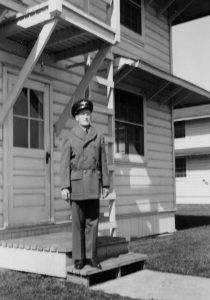 hit me that he was stationed as a communications officer at RAF Horham, Suffolk, England. Of course, my curious mind had to go to Google Earth. I wanted to know if the Air Base was still visible, because most of them have been in one way or another returned to farm land. I did find the base, and while it’s outline isn’t as clearly marked as Great Ashfield is, I could pick out RAF Horham too. After finding the base, I was able to imagine a young Uncle Frank living and working there during the war. To me, that thought was very interesting, but another thing I noticed was the fact that Horham was not that far from Great Ashfield. In fact, my dad and Bob’s Uncle Frank were stationed a mere 22 miles away from each other. It is doubtful that they ever met, and if they did, they probably wouldn’t remember it, because it would be just in passing, but it occurs to me now, that the two men have probably met in Heaven, and they probably had some interesting stories to tell about their time in England.
hit me that he was stationed as a communications officer at RAF Horham, Suffolk, England. Of course, my curious mind had to go to Google Earth. I wanted to know if the Air Base was still visible, because most of them have been in one way or another returned to farm land. I did find the base, and while it’s outline isn’t as clearly marked as Great Ashfield is, I could pick out RAF Horham too. After finding the base, I was able to imagine a young Uncle Frank living and working there during the war. To me, that thought was very interesting, but another thing I noticed was the fact that Horham was not that far from Great Ashfield. In fact, my dad and Bob’s Uncle Frank were stationed a mere 22 miles away from each other. It is doubtful that they ever met, and if they did, they probably wouldn’t remember it, because it would be just in passing, but it occurs to me now, that the two men have probably met in Heaven, and they probably had some interesting stories to tell about their time in England.
As big as this old world is, and as unlikely as it seems that two families could have some close connections like this, I find that at least in my life, and my husband’s life, there are some connections, some very near misses, and some interesting encounters. Like my dad, Uncle Frank served out his time in the Army Air Forces right there 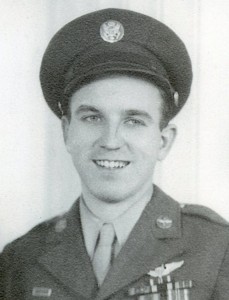
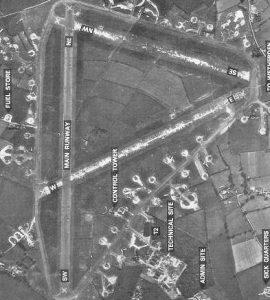 at RAF Horham, Suffolk, England. I imagine that like my dad, Frank took at least one leave to go and see London, because how could you go to England and not see London. Frank had a successful career in communications and then after his discharge from the service, four years, four months and four days of active duty, separating at war’s end with the rank of major. Frank served with distinction, earning a Bronze Star and the Air Medal, then he continued his military career in the Air Force Reserve. He retired in 1968 with the rank of Lieutenant Colonel. Today would have been Uncle Frank’s 98th birthday, and it is his first in Heaven. Happy birthday in Heaven, Uncle Frank. We love and miss you very much.
at RAF Horham, Suffolk, England. I imagine that like my dad, Frank took at least one leave to go and see London, because how could you go to England and not see London. Frank had a successful career in communications and then after his discharge from the service, four years, four months and four days of active duty, separating at war’s end with the rank of major. Frank served with distinction, earning a Bronze Star and the Air Medal, then he continued his military career in the Air Force Reserve. He retired in 1968 with the rank of Lieutenant Colonel. Today would have been Uncle Frank’s 98th birthday, and it is his first in Heaven. Happy birthday in Heaven, Uncle Frank. We love and miss you very much.
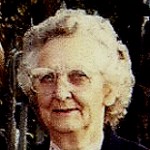 Many people say they would hate to be born on a holiday, and for the most part I think I agree, but while it isn’t really a “holiday,” Groundhog Day, for my husband’s grandmother, Vina Hein, was a special day. When she was born on February 2, 1909, Groundhog Day in the United States was a mere 22 years old. There are lots of differing views on how it came to be, but apparently, it is pretty much an American tradition. It is thought to be a spinoff, of sorts, of a tradition that started with the early Christians in Europe, and for centuries the custom was to have the clergy bless candles and distribute them to the people. Even then, it marked a milestone in the winter and the weather that day was important. On old song about the day went thus: If Candlemas be fair and bright, Come, Winter, have another flight; If Candlemas brings clouds and
Many people say they would hate to be born on a holiday, and for the most part I think I agree, but while it isn’t really a “holiday,” Groundhog Day, for my husband’s grandmother, Vina Hein, was a special day. When she was born on February 2, 1909, Groundhog Day in the United States was a mere 22 years old. There are lots of differing views on how it came to be, but apparently, it is pretty much an American tradition. It is thought to be a spinoff, of sorts, of a tradition that started with the early Christians in Europe, and for centuries the custom was to have the clergy bless candles and distribute them to the people. Even then, it marked a milestone in the winter and the weather that day was important. On old song about the day went thus: If Candlemas be fair and bright, Come, Winter, have another flight; If Candlemas brings clouds and 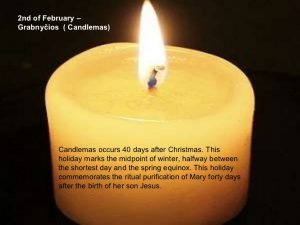 rain, Go Winter, and come not again. It all sounds quite familiar doesn’t it? Of course in the Christian religion, it meant something else. It is half way through winter, and it was also thought to be when Mary’s purification day occurred after Jesus was born.
rain, Go Winter, and come not again. It all sounds quite familiar doesn’t it? Of course in the Christian religion, it meant something else. It is half way through winter, and it was also thought to be when Mary’s purification day occurred after Jesus was born.
Nevertheless, leave it to Americans to make their warm weather travel plans based on the machinations of a reticent rodent. Each year, groundhogs around the country…but most notably Punxsutawney Phil of Punxsutawney, Pennsylvania, are paraded out to predict how many more weeks will transpire before spring is on the way. It’s either six more weeks of winter…as was the case with Punxsutawney Phil this year, or an early spring. It all depends upon  whether the groundhog sees his shadow or not. This tradition has been going on since 1887s, despite modest advances in weather prediction since that time…if you think the weatherman knows his business that is.
whether the groundhog sees his shadow or not. This tradition has been going on since 1887s, despite modest advances in weather prediction since that time…if you think the weatherman knows his business that is.
So, while it was not a major holiday, Grandma Hein’s birthday always had an added little bit of sparkle. If her wish came true, the groundhog would predict an early spring, because after all, who isn’t ready for the beautiful flowers of spring in the dead of winter. Today would have been Grandma Hein’s 109th birthday if she were still here. Grandma, I know that where you are, the Spring flowers are always blooming. Happy birthday in Heaven Grandma. We love and miss you very much.
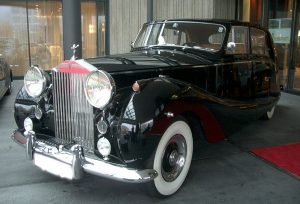 I don’t know…yet, if my son-in-law, Travis Royce has any connection to the Rolls-Royce families, but since my daughter, Amy Royce, and her husband Travis named their son Caalab Rolles Royce, I have felt a bit of a tie to the Rolls Royce vehicle line. Yes, my grandson’s middle name is spelled differently, but it makes it seem more like a last name and not a physical action. Because of my daughter’s family name, and my grandson’s name, I tend to read a story that is about the Rolls Royce. It just jumps out at me.
I don’t know…yet, if my son-in-law, Travis Royce has any connection to the Rolls-Royce families, but since my daughter, Amy Royce, and her husband Travis named their son Caalab Rolles Royce, I have felt a bit of a tie to the Rolls Royce vehicle line. Yes, my grandson’s middle name is spelled differently, but it makes it seem more like a last name and not a physical action. Because of my daughter’s family name, and my grandson’s name, I tend to read a story that is about the Rolls Royce. It just jumps out at me.
The Rolls-Royce cars are…high end elegance. They were first manufactured in 1904 By Henry Royce and Charles Rolls. These were not two men who were friends, and decided to build a car. Henry Royce was fourteen years older that Charles Rolls. He was a big, bearded, solid man, a workaholic and perfectionist, who worked hard for everything he had. As Rolls later said, he was “no ordinary man but a man of exceptional ingenuity and power of overcoming difficulties.” He was of Cambridgeshire farming stock…the son of a struggling miller. He had begun to earn money as a paper boy aged nine, somehow got an education at night school and took an engineering apprenticeship. Then he started an electrical engineering business in Manchester before designing and building his own car. It made an excellent impression for speed and reliability on a keen motorist named  Henry Edmunds, who knew Charles Rolls and more or less dragged him to meet Royce in Manchester. The two men became instant partners and agreed to form the Rolls-Royce car company. Rolls was so delighted with Royce’s quiet little two-cylinder car that he borrowed it on the spot, drove it back to London, woke Claude Johnson up in the middle of the night and insisted on giving him a ride in it. By the end of 1904 the first Rolls-Royces were came out, with the now characteristic radiator that would become the world’s best-known symbol of supreme motoring excellence.
Henry Edmunds, who knew Charles Rolls and more or less dragged him to meet Royce in Manchester. The two men became instant partners and agreed to form the Rolls-Royce car company. Rolls was so delighted with Royce’s quiet little two-cylinder car that he borrowed it on the spot, drove it back to London, woke Claude Johnson up in the middle of the night and insisted on giving him a ride in it. By the end of 1904 the first Rolls-Royces were came out, with the now characteristic radiator that would become the world’s best-known symbol of supreme motoring excellence.
The Silver Wraith was the first post-war Rolls-Royce. It was made from 1946 to 1958. It was designed for coachbuilders, and so was only a chassis. It was announced by Rolls-Royce in April 1946 as the 25/30 horsepower replacement for the 1939 Wraith in what had been their 20 horsepower and 20/25 horsepower market sector, that is to say Rolls-Royce’s smaller car. The size was chosen to be in keeping with the mood of post-war austerity. Even very limited production of the chassis of the larger car, the Phantom IV, was not resumed until 1950 and then, officially, only for Heads of State. The car had improvements, such as chromium-plated cylinder bores for the engine; a new more rigid chassis frame to go with new independent front suspension and a new synchromesh gearbox. The chassis now had centralized lubrication. The engine was a straight six-cylinder, which had been briefly made for the aborted by war Bentley Mark V. To this prewar mix Rolls-Royce added chromed bores. Initially, this engine had the Mark V’s capacity of 4,257 cc. It was increased from 1951 to 4,566 cc and in 1955, after the introduction of the Cloud, to 4,887 cc  for the remaining Silver Wraiths.
for the remaining Silver Wraiths.
Personally, I would love to find the connection between my grandson and Henry Royce, which I suspect exists. Of course, the whole family would be connected, but Caalab’s connection would be especially cool, because of the tie to his name. When he got old enough to think about cars, he told me that he was going to buy a 97 Rolls Royce for his name and birth year. I suppose he still could, but I think they are getting pretty scarce these days, at least for that specific year. Nevertheless, the Silver Wraith was never something Caalab was interested in, as far as I know.
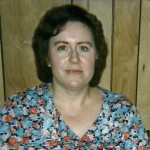 My husband’s aunt, Margee Kountz is his mother Joann Schulenberg’s youngest sister. When Joann developed Alzheimer’s disease, Margee was a vital part of our team of caregivers for her. Whenever I had to take my father-in-law, Walt Schulenberg to the doctor, Margee happily gave of her time to come and sit with her sister. People may not realize just how vital their visits can be. When a family of caregivers are working hard to keep their loved one in good health, the caregivers can find themselves feeling exhausted. That visit, while it make seem such a little thing, allows the caregiver time to get necessary things done, and a little bit of time to take a break from the work, and at least a little bit of the stress of caring for their patient. Caregiving is about love. You do it because to love your patient, but it is not without it’s stresses, worry, and exhaustion. The nice thing about the Respite Care worker is that they are a huge part of the team of people who perform two services…companionship for the patient and time off for the caregiver. They are priceless, and Margee always stepped up to help.
My husband’s aunt, Margee Kountz is his mother Joann Schulenberg’s youngest sister. When Joann developed Alzheimer’s disease, Margee was a vital part of our team of caregivers for her. Whenever I had to take my father-in-law, Walt Schulenberg to the doctor, Margee happily gave of her time to come and sit with her sister. People may not realize just how vital their visits can be. When a family of caregivers are working hard to keep their loved one in good health, the caregivers can find themselves feeling exhausted. That visit, while it make seem such a little thing, allows the caregiver time to get necessary things done, and a little bit of time to take a break from the work, and at least a little bit of the stress of caring for their patient. Caregiving is about love. You do it because to love your patient, but it is not without it’s stresses, worry, and exhaustion. The nice thing about the Respite Care worker is that they are a huge part of the team of people who perform two services…companionship for the patient and time off for the caregiver. They are priceless, and Margee always stepped up to help.
My mother-in-law, Joann passed away on January 4, 2018. We are no longer caregivers or respite care workers. She is at peace, but we are left behind to mourn her loss. For Margee, it means that she is the oldest member of the family…something she did not want to be. Not because of the age, but because it has been so hard for her to say goodbye to her older sisters. I think that in many ways she feels like “the last of one standing,” and that’s not what she ever wanted. I know the feeling. It is not so very much different from being orphaned, which happens to all of us when our parents pass away. Still, we hope our siblings will live, at least, close to as long as we do, because when your parents and your siblings are gone, you feel truly alone. Of course, Margee isn’t really alone. She has her children grand children, and a great grandson too, but there is just a strange feeling that goes along with being the last of the original family.
While Margee was a big part of taking care of her sister, and the caregivers who worked during those years, I’m not entirely sure she ever knew just how important she really was. She was, sort of, an unsung hero. I’m sure I could have taken my mother-in-law to my father-in-law’s doctor’s appointments, but it would have been 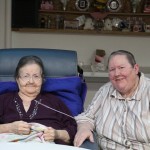 a huge undertaking for one person. Margee took half of that load off of me, and gave my mother-in-law a much needed social session too. She can to visit, and it gave my mother-in-law a new perspective on life. Their conversation stimulated her mind some. They talked about the old days, their kids, all the fun they had. They didn’t share their growing up years, because just six months after Margee was born, my in-laws were married. Nevertheless, there was much to talk about. Each could compare their childhood to the others, maybe. It wouldn’t really matter what they talked about, because after all, the visits were Margee’s gift of love for her sister. And that is what makes respite care priceless. Today is Margee’s birthday. Happy birthday Margee!! Have a great day!! We love you!!
a huge undertaking for one person. Margee took half of that load off of me, and gave my mother-in-law a much needed social session too. She can to visit, and it gave my mother-in-law a new perspective on life. Their conversation stimulated her mind some. They talked about the old days, their kids, all the fun they had. They didn’t share their growing up years, because just six months after Margee was born, my in-laws were married. Nevertheless, there was much to talk about. Each could compare their childhood to the others, maybe. It wouldn’t really matter what they talked about, because after all, the visits were Margee’s gift of love for her sister. And that is what makes respite care priceless. Today is Margee’s birthday. Happy birthday Margee!! Have a great day!! We love you!!
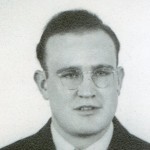
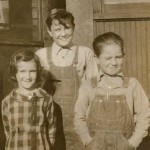 My Uncle Bill Spencer discovered genealogy by chance, when he came across a little black book that his mother, Anna Schumacher Spencer had. When he asked about it, she showed it to him. In the book was all she knew about her family’s history. I don’t know if my grandmother had an interest in the family history, but very little time to pursue it, or if it was passed down to her by someone else. Whatever the case may be, Uncle Bill was hooked on the family history from that time forward…an amazing feat for an 8 year old boy. It was a project he spent serious time on for all of his pre-dementia life. The family history and all the possible information were two things that were never far from his thoughts. His mind was obsessed with it.
My Uncle Bill Spencer discovered genealogy by chance, when he came across a little black book that his mother, Anna Schumacher Spencer had. When he asked about it, she showed it to him. In the book was all she knew about her family’s history. I don’t know if my grandmother had an interest in the family history, but very little time to pursue it, or if it was passed down to her by someone else. Whatever the case may be, Uncle Bill was hooked on the family history from that time forward…an amazing feat for an 8 year old boy. It was a project he spent serious time on for all of his pre-dementia life. The family history and all the possible information were two things that were never far from his thoughts. His mind was obsessed with it.
The Spencer Family History researched by my Uncle Bill without the benefit of modern computer data assistance, spanned some 80+ years. He worked on it because of his own curiosity, at first. He traveled to spend time in court records rooms, searching for clues. He walked countless cemeteries, looking for the graves of his ancestors. He meticulously documented every picture, every find, and every news article he came across. He talked to aunts, uncles, and family friends, and wrote down their stories. He wanted to know everything…not just names and faces, but who these people were, and what their lives were about.
At some point, Uncle Bill’s obsession became Uncle Bill’s gift. He wanted to preserve the Spencer Family History to be passed down to all of the children of his multi-great grandparents. It was his legacy. He had such great love for the past, and really enjoyed researching history and ancestry. And his plan was to get the family history out to as many family members as he could. I have been amazed at how far it has gone across the United States and probably the world. I have come across a number of people who have all or part of Uncle Bill’s history. He made copies of it for anyone who asked, or showed an interest. These were all done by hand. Although, he did use a copier in the later years. His was a work of love for the future generations, who might 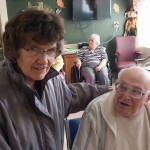
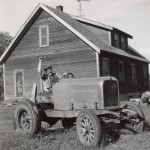 find an interest someday, even if they didn’t seem interested now. While Uncle Bill’s mission seemed very much like an obsession, it was really a gift obsession. He was obsessed about giving it away. Few people have ever worked a lifetime on a gift that would be given away to people as yet unborn and unknown. It was a gift than was priceless to the receiver. Uncle Bill had given the very best of himself and poured it into the family history, and I for one feel very blessed to receive Uncle Bill’s gift. Today is my Uncle Bill’s 96th birthday. Happy birthday Uncle Bill!! Have a great day!! We love you!!
find an interest someday, even if they didn’t seem interested now. While Uncle Bill’s mission seemed very much like an obsession, it was really a gift obsession. He was obsessed about giving it away. Few people have ever worked a lifetime on a gift that would be given away to people as yet unborn and unknown. It was a gift than was priceless to the receiver. Uncle Bill had given the very best of himself and poured it into the family history, and I for one feel very blessed to receive Uncle Bill’s gift. Today is my Uncle Bill’s 96th birthday. Happy birthday Uncle Bill!! Have a great day!! We love you!!

